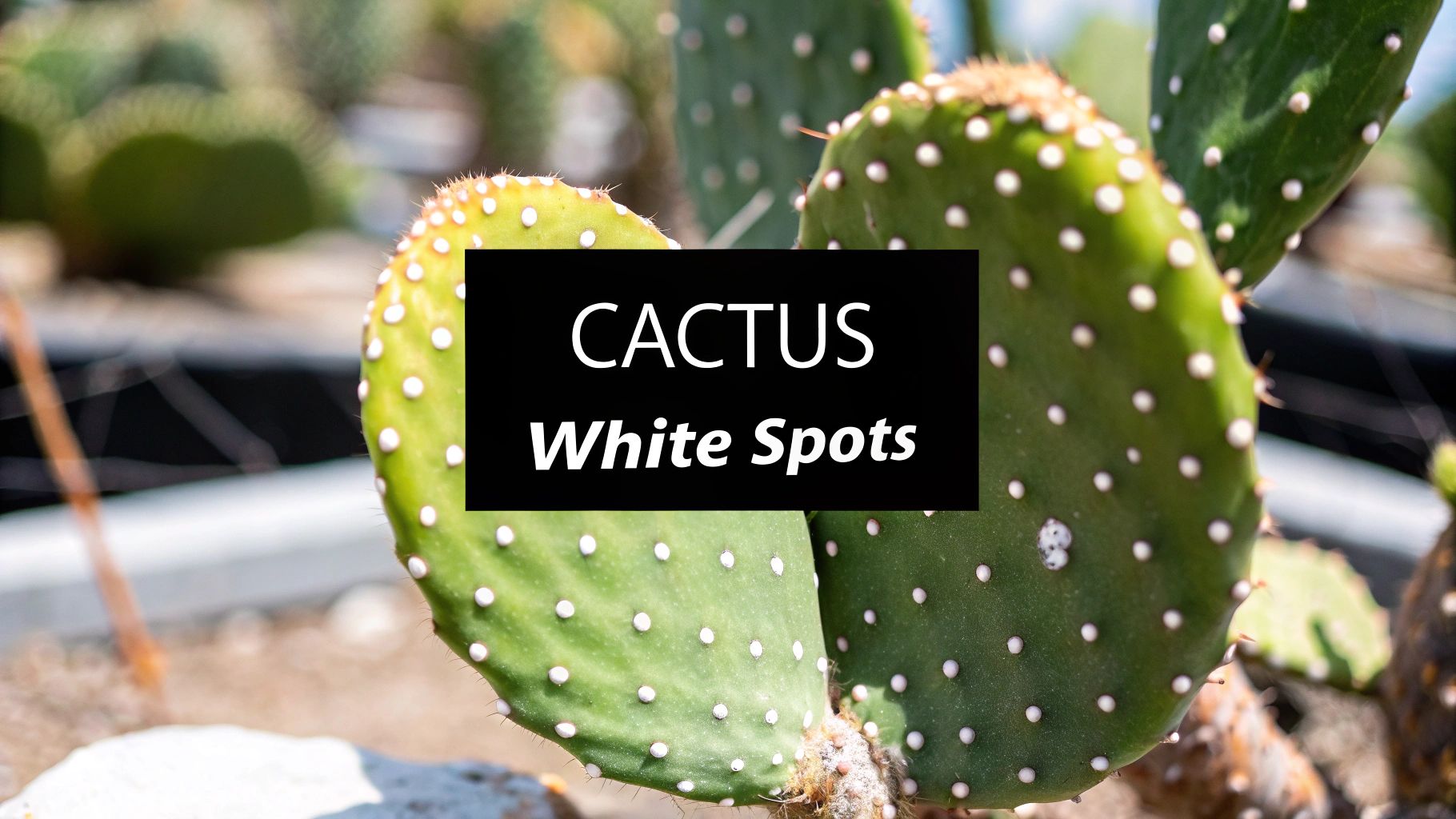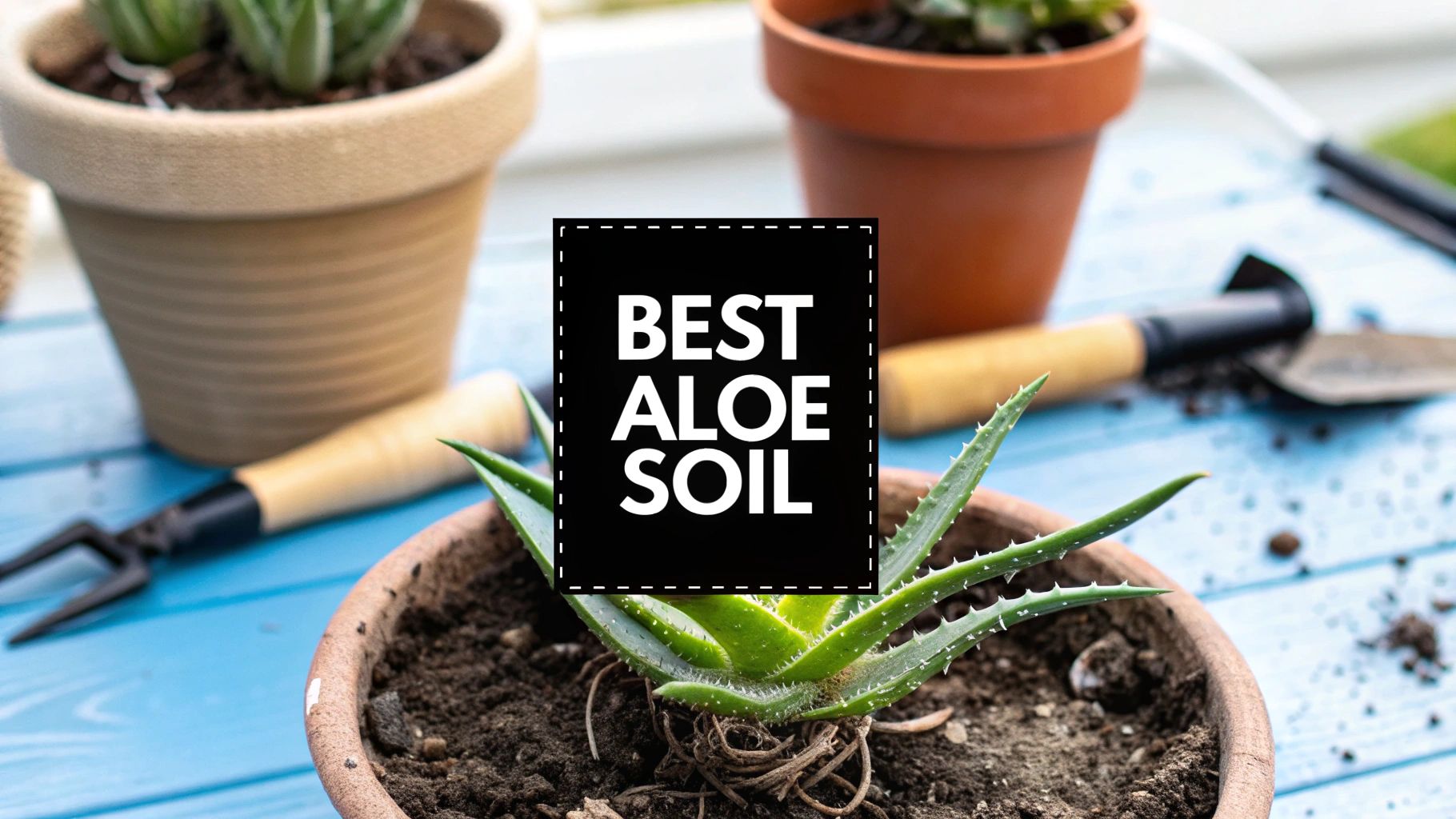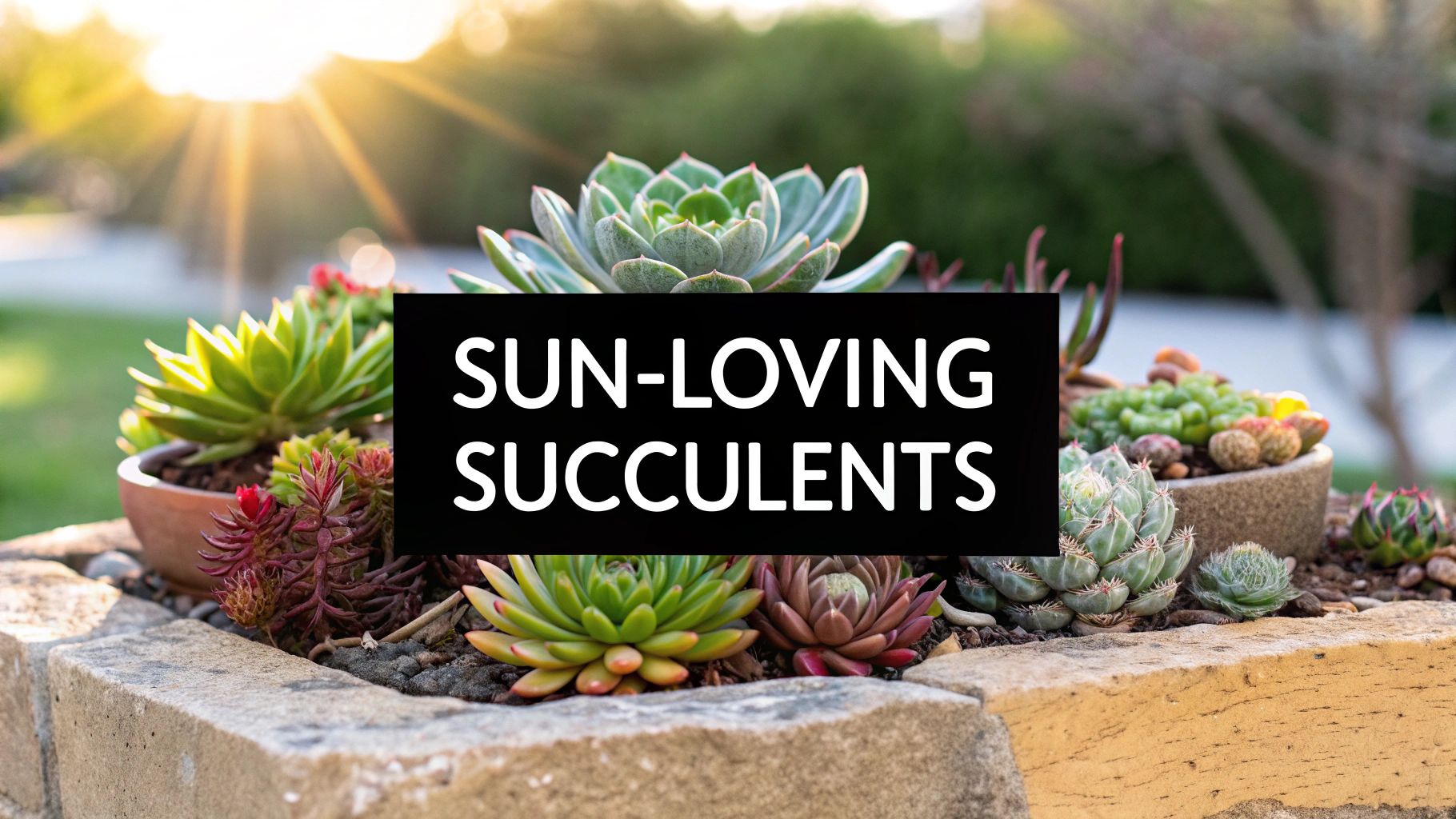I get this question all the time: "How often should I water my cactus?" People want a simple, straightforward answer, like "once every two weeks." If you're looking for a quick rule of thumb, most cacti do well with watering every 2-4 weeks during their spring and summer growing season and every 4-6 weeks in the fall and winter when they’re dormant.
But here's the honest truth from someone who's seen it all: treating that as a strict rule is one of the fastest ways to kill your cactus. The real answer is, and always will be, "it depends."
Your Cactus Watering Questions Answered
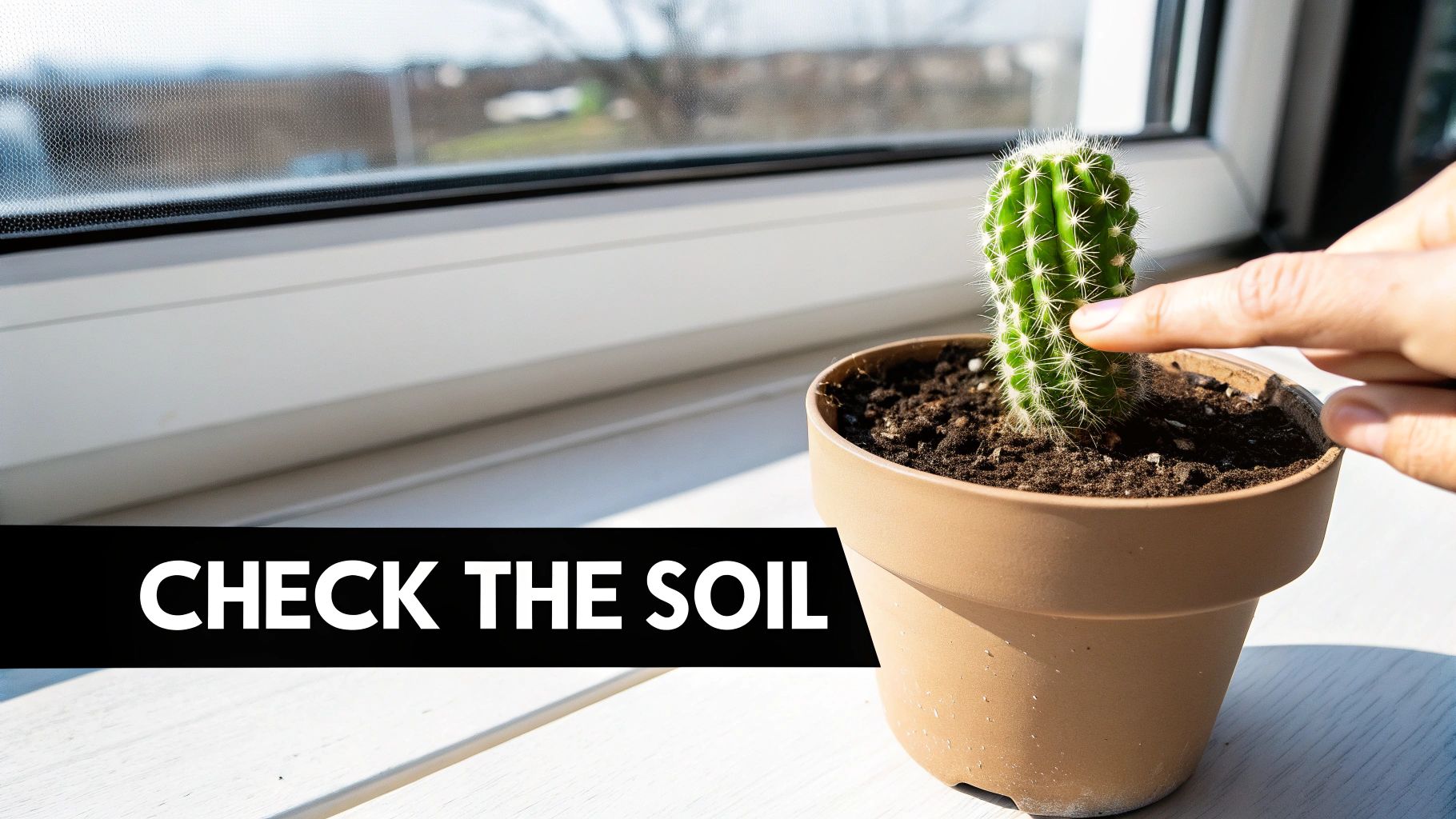
Relying on a calendar schedule is a trap. It's a tempting shortcut, I know, but it completely ignores what's actually happening with your plant in your home. A rigid routine doesn't account for the light, humidity, pot type, or soil mix—all the little things that create a unique ecosystem for your cactus and determine how thirsty it really is.
The single most important habit you can develop is to check the soil, not the calendar. This is the mental shift that takes you from a nervous new plant owner to a confident one. You want to mimic the desert's cycle of drenching rain followed by a long dry spell. That means watering deeply, but only when the soil is bone dry all the way through.
A Seasonal Guideline to Get You Started
While checking the soil is king, it helps to have a general idea of how a cactus's needs change with the seasons. Think of the following table as a starting point—a rough guide to get you oriented, not a set of hard-and-fast rules.
General Cactus Watering Frequency by Season
This table provides a quick-reference guide to typical watering intervals. Use it as a starting point, but always let your plant's soil tell you when it's actually thirsty.
| Season | Typical Watering Frequency | Key Consideration |
|---|---|---|
| Spring | Every 3-4 Weeks | As days get longer and warmer, your cactus starts to wake up. This is when you can begin to gradually increase watering. |
| Summer | Every 2-3 Weeks | This is the peak growing season. Your cactus is most active and will need more frequent, thorough watering once the soil is completely dry. |
| Fall | Every 4-5 Weeks | Growth starts to slow down. As the light fades and temperatures cool, it's time to taper off your watering frequency. |
| Winter | Every 5-6 Weeks (or less) | Most cacti go dormant and are just resting. Water very sparingly, just enough to keep the roots from completely desiccating. Some people don't water at all. |
This is just a baseline. From my experience, a small cactus in a terracotta pot sitting in a hot, sunny window might need water far more often than a large one in a glazed ceramic pot in a cooler, north-facing room.
Key takeaway: A seasonal guide is helpful, but it's not a substitute for checking your plant. The specific conditions in your home will always be the deciding factor.
Understanding these basic cycles is the first step. If you want to build a solid foundation of knowledge, exploring resources that offer general plant care and maintenance tips can be incredibly helpful. Next, we'll get into the nitty-gritty of how to read the signs from your plant, pot, soil, and environment to fine-tune this schedule perfectly.
How the Seasons Change Your Watering Game
To get cactus watering right, you have to learn to think like a plant. Cacti don't check the calendar; they follow the sun and the seasons. Their entire life cycle is tied to this natural rhythm, and your watering habits need to follow suit. Sticking to a single schedule all year round is one of the quickest ways to kill a cactus.
During the long, warm days of spring and summer, your cactus is in its active growth phase. This is its busy season—it’s producing new pads, maybe flowering, and generally burning a lot of energy. All that activity requires water to fuel its metabolism, making this the time your plant will be at its thirstiest.
Once fall and winter roll around, everything changes. The cactus slips into dormancy, which is basically its rest period. With shorter days and less intense light, growth grinds to a halt. As you'd expect, its water needs drop dramatically. Watering a dormant cactus like it's still mid-summer is a recipe for disaster, almost guaranteeing root rot.
Spring and Summer: The Growing Season
When spring finally arrives, you'll start to see signs of life. Maybe the plant looks a bit plumper, or you spot some tiny new spines emerging. That's your cue to gradually start watering more. Give it a thorough soak, let the soil dry out completely, and then wait another couple of days before you even think about watering again.
By the time summer is in full swing, your cactus will be much thirstier. If it's in a hot, sunny window, you might find yourself doing a deep soak every two to three weeks. But don't just guess—always check the soil first. If it's bone-dry a couple of inches down, it's time to give it a good drink.
A Pro's Perspective: The best way to water in the growing season is to mimic a desert downpour. Water deeply and thoroughly until it runs out the bottom, saturating the entire root ball. Then, let it get completely dry. This "drench and dry" method is exactly what cacti are built for.
Fall and Winter: The Dormant Period
As soon as you feel that first hint of autumn in the air, it's time to start pulling back on the water. The shorter days and cooler temperatures are nature's signal for your cactus to prepare for its winter nap. You need to reduce both how often and how much you water.
In the dead of winter, watering should be downright minimal. For most of my cacti, a light watering once every five or six weeks is more than enough to keep them happy. Some collectors I know in colder climates stop watering entirely from December to February. The plant isn't growing, so it just doesn't need the fuel. A tiny bit of water prevents the roots from drying out completely, but that's it.
A great example comes from European growers in Mediterranean climates. They typically start watering around the end of March and stop completely by mid-September. During that active period, they'll water most cacti roughly every 15 days, shortening the interval to every 8–10 days during a real heatwave. You can find more great tips on how Italian growers manage their cacti on ilfioretralespine.it.
Reading Your Home's Unique Environment
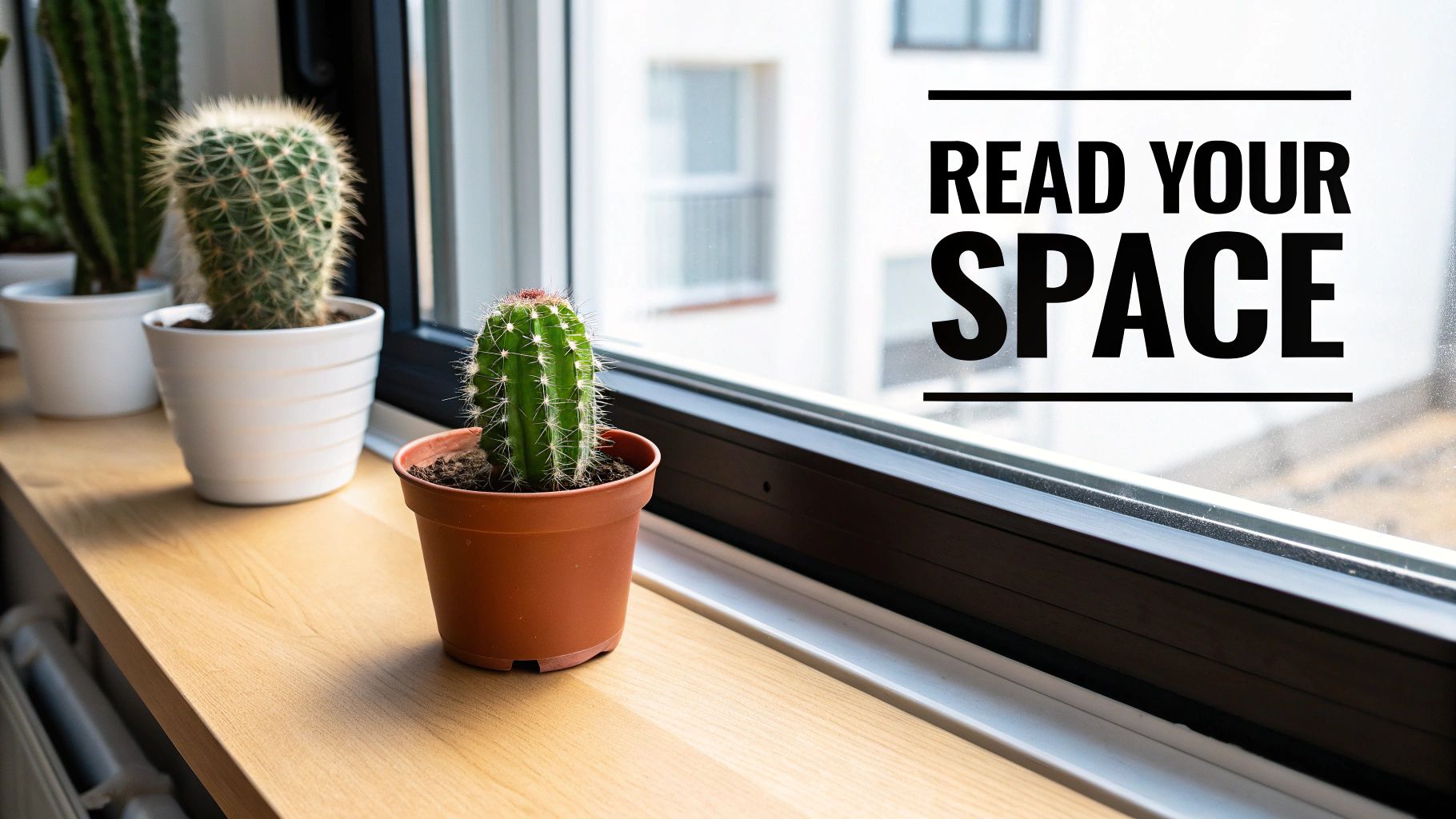
The seasonal guidelines are a fantastic starting point, but they're only half the story. To really nail down your cactus watering schedule, you have to look beyond the calendar and learn to read the microclimate inside your own home. Every house is a unique ecosystem, and its specific conditions will dramatically change how thirsty your cactus gets.
Think about it: a cactus sitting in a bright, warm, south-facing window is working hard all day. The intense light and heat mean it's photosynthesizing like crazy and losing moisture much faster. That plant will dry out significantly quicker than the exact same cactus placed in a cooler room with less direct sun.
These environmental factors are just as crucial as the season—sometimes even more so. A plant in a bone-dry, centrally-heated home in January has very different needs than one in a naturally humid bathroom. Learning to "read" your space is the key to moving beyond generic advice and developing a true feel for what your plants need.
How Light and Heat Dictate Thirst
Sunlight is the fuel for your cactus’s engine. The more intense light it gets, the more active it becomes and the more water it uses. A cactus basking in hours of direct sun is essentially running a marathon; one in a lower-light spot is just taking a leisurely stroll.
Temperature works in a similar way. Warmer air speeds up transpiration (the plant-world equivalent of sweating) and also evaporates moisture from the soil much faster.
The interplay between light and heat is where things get interesting. Let’s look at a couple of real-world scenarios:
- Scenario A: The Sun-Soaked Apartment. Imagine a Golden Barrel cactus on a west-facing balcony in a hot, dry climate. It’s getting blasted with intense afternoon sun and heat. Its soil will likely be bone-dry and need a good soak every 7-10 days in the summer.
- Scenario B: The Cool Office. Now, picture that same Golden Barrel cactus in a bright office with large north-facing windows. It gets plenty of indirect light but no direct sun, and the thermostat is always at a steady 70°F (21°C). This cactus will need water far less often, maybe only once every 3-4 weeks, even in peak summer.
Knowing where to place your plant is a huge part of managing its water needs. If you need a little guidance, we have a whole article on finding the best place to put a cactus in the house.
Humidity and Airflow Matter, Too
Humidity—the amount of moisture in the air—directly impacts how fast the soil dries out. If your home is very dry (a common issue when the heat is on all winter), moisture will get pulled from the soil and the plant more quickly. On the flip side, a cactus in a steamy bathroom will hold onto its moisture for much longer.
A common mistake is thinking a cactus in a dry room automatically needs more water. The soil surface might dry out fast, but you have to make sure it's dry all the way down. Don't let a crusty top layer trick you into overwatering.
Even the broader climate you live in makes a difference. For instance, cactus watering frequency in Australia is tied to its distinct seasons. During the summer heat from December to February, it's not uncommon to give them a full soak once a week—but only if the soil is completely dry. Contrast that with the cooler months from June through August, when a light drink just once every three weeks is often plenty. You can find more great tips on caring for cacti in the Australian climate on cactusculture.com.au.
Choosing the Right Pot and Soil Mix
Get your watering schedule perfect, and it can still all go wrong if your cactus is sitting in the wrong pot and soil. This foundation is just as important as how often you water. Think of the pot and soil as a single system designed to keep your cactus’s roots healthy and dry.
Cacti are desert plants, and the one thing they absolutely cannot stand is having “wet feet.” If the soil stays soggy, the roots can’t breathe. This leads to root rot, which is often a point of no return for these tough little plants.
Why Your Pot Choice Matters
The material your pot is made from has a massive impact on how quickly the soil dries out. I know how tempting those beautiful glazed ceramic or sleek plastic pots can be, but they’re usually a terrible choice for a cactus. They don’t breathe, trapping moisture and creating a swampy environment for the roots.
This is why you see so many cacti in classic terracotta pots. Unglazed clay is porous, meaning air and water can actually pass through the walls of the pot. This helps wick moisture out of the soil, allowing it to dry much more quickly and evenly—it’s like a built-in safety feature against overwatering.
Pro Tip: Whatever you choose, a drainage hole is non-negotiable. If water can't escape, it will pool at the bottom and rot the roots, no matter what kind of soil you use. If you fall in love with a pot that doesn't have a hole, you'll need to use it as a decorative "cache pot" and keep your cactus in a separate nursery pot with drainage inside it.
The right pot is a game-changer. It helps regulate moisture, provides airflow to the roots, and works with your soil to create an environment where your cactus can truly thrive. To help you decide, here’s a quick breakdown of the most common materials.
Cactus Pot Material Comparison
| Material | Pros | Cons | Best For |
|---|---|---|---|
| Terracotta (Unglazed Clay) | Excellent airflow, porous, dries soil quickly, inexpensive. | Can dry out too fast in hot climates, fragile. | Beginners and anyone prone to overwatering. The gold standard for cacti. |
| Glazed Ceramic | Aesthetically pleasing, wide variety of designs, heavy and stable. | Non-porous, traps moisture, can lead to root rot if not careful. | Experienced growers who have their watering routine perfected. |
| Plastic | Lightweight, cheap, retains moisture longer. | Very little airflow, easy to overwater, can become brittle in the sun. | Nurseries (for temporary housing) or very dry, hot climates where terracotta dries too fast. |
| Concrete/Stone | Very durable and stable for large plants, modern look. | Can be very heavy, retains heat, and often lacks drainage. | Large, mature cacti outdoors, provided there is ample drainage. |
Ultimately, while you can make other materials work with careful watering and the right soil, terracotta is almost always the safest and most forgiving choice for your cactus.
The Right Soil Is Everything
Never, ever use standard potting mix for a cactus. That stuff is designed to hold onto water for leafy tropicals, which is the exact opposite of what a cactus needs. It’s dense, stays wet, and will suffocate the roots.
You need a soil mix that’s gritty, airy, and drains like a sieve. A great cactus soil is more mineral than organic. When you water it, you want to see the water run straight through and out the bottom almost immediately.
Look for a mix that contains ingredients like:
- Pumice or Perlite: These are lightweight volcanic rocks that create air pockets and prevent the soil from compacting.
- Coarse Sand: Adds grit and structure, ensuring water can flow freely.
- A little organic matter: A small amount of compost or coco coir is fine for nutrients, but it should never be the main ingredient.
If you really want to give your plant the best possible start, mixing your own soil is the way to go. You can find our favorite recipe in our guide on how to make cactus soil. A fast-draining soil is the key to preventing problems before they even start.
Mastering the 'Soak and Dry' Watering Method
When it comes to watering cacti, how you do it is just as important as how often. The tried-and-true technique for almost every cactus out there is what we call the 'soak and dry' method. It’s designed to perfectly mimic the cycle of rare, heavy downpours followed by long dry spells that these plants are built for in their native deserts.
Forget giving your cactus little sips of water here and there. That’s one of the most common mistakes, and it only encourages a weak, shallow root system that hangs out near the surface. Instead, the soak and dry method pushes the roots to grow deep and strong, searching for moisture throughout the entire pot, making for a much tougher plant.
It’s a simple concept. When it’s watering day, you give the soil a complete and total drenching. Keep watering until you see it pouring freely from the drainage hole at the bottom of the pot. This ensures the entire root ball gets a good, long drink. Then comes the "dry" part, which is just as crucial: you have to let that soil dry out completely before you even think about watering again.
Having the right setup from the start is half the battle. This infographic shows the basic steps for potting your cactus correctly, which is the foundation for any successful watering routine.
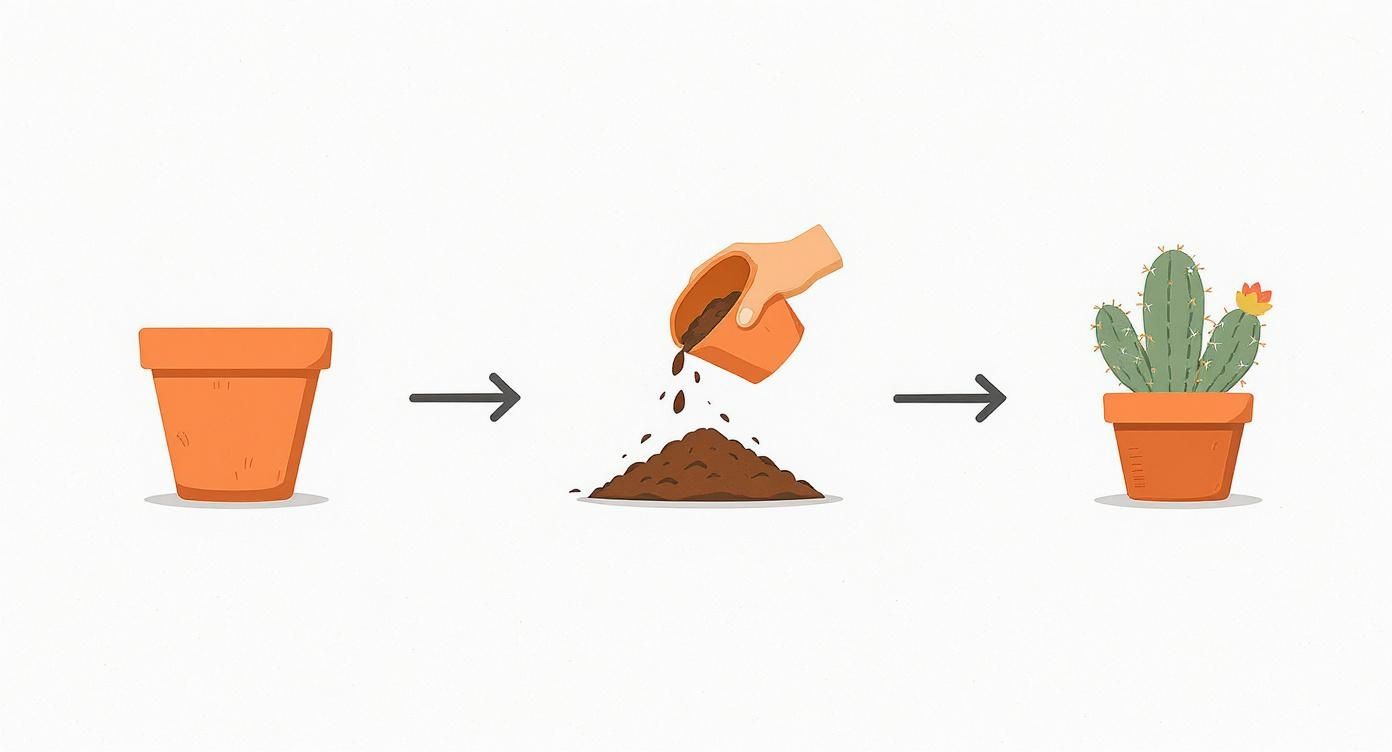
Starting with the right pot and soil mixture makes everything else, including watering, so much easier.
How to Tell When the Soil Is Truly Dry
So, how do you know for sure that the soil is bone dry? Don't just check the surface. The soil at the very bottom of the pot is always the last to dry out, so that's where you need to focus.
Here are a few foolproof ways to check for moisture:
- The Finger Test: This is the easiest and most direct method. Just stick your index finger deep into the soil. If you feel any hint of moisture or coolness, it's not ready. Wait a few more days.
- The Skewer Trick: A great way to check the very bottom of the pot. Grab a wooden skewer or an unused chopstick and push it all the way down to the base. If it comes out clean and dry, you’re good to go. If it has damp soil clinging to it, give it more time.
- The Weight Check: After a while, you’ll get a feel for this. A freshly watered pot is surprisingly heavy compared to a completely dry one. Lift it right after watering and then again a week or two later to learn the difference. It quickly becomes a very reliable gut check.
The soak and dry method works because cacti are the ultimate survivors. Research confirms that many desert cacti can go for months without water by basically going dormant. Their roots, which are typically quite shallow at just 15–30 cm deep, are evolved to soak up huge amounts of water from those rare desert storms. This watering technique is the closest you can get to replicating that natural cycle. You can even read the full research on cactus physiology on academic.oup.com if you want to geek out on the science.
A Few Pro Tips to Refine Your Technique
A couple of final pointers can make this method even more effective. First, always try to water in the morning. This gives the plant the entire day to start drawing up the moisture and allows any excess water on the surface to evaporate, which helps keep fungal problems at bay.
Second, stick with room-temperature water. Pouring ice-cold or hot water on your plant can seriously shock its roots. Tap water is generally fine, but if you want to be extra careful, let it sit out for 24 hours to allow some of the chlorine to dissipate. And while this method is perfect for cacti, you might also want to learn how to water succulent plants, as they follow similar (but not identical) principles.
Common Cactus Watering Questions
Even with a solid plan, questions are bound to pop up. Knowing the "rules" for cactus care is one thing, but figuring out what your specific plant needs when it's sitting right there in your living room is another story entirely. Let's dig into some of the most common worries and questions I hear from fellow cactus growers.
What Are the Signs of an Overwatered Cactus?
An overwatered cactus is a plant in serious trouble, and it will definitely let you know. The most tell-tale sign is the cactus becoming soft, mushy, or even a bit wobbly. This rot usually starts at the base and creeps its way up. You might also notice the color changing to a sickly yellow or a translucent, sickly brown.
Your soil is another big clue. If it’s always damp to the touch or takes more than a week to dry out completely, you’re creating a dangerous environment for your plant's roots.
Keep an eye out for these other red flags:
- A musty or rotten smell coming from the soil.
- Little fungus gnats buzzing around the pot.
- The plant leaning over as its root system literally rots away.
If you even suspect overwatering, you need to act fast. Stop watering immediately and gently check the roots. Healthy roots are firm and white, while rotten ones are brown or black, feel mushy, and might even fall apart in your hands. Often, the only way to save the plant is to repot it into fresh, completely dry cactus soil.
How Do I Know if My Cactus Is Underwatered?
Here's the good news: an underwatered cactus is usually much, much easier to save. A thirsty cactus starts using up its internal water reserves, which makes it look shriveled, wrinkled, or puckered. It might also lose its vibrant color, looking a bit dull, and it will feel surprisingly light if you pick it up.
Unlike a waterlogged plant, a thirsty one almost always perks right back up after a good, deep drink. Give it a thorough soak until water runs out the bottom, and you should see it plump back up within a day or two. Another dead giveaway is when the soil has become so dry that it's physically pulling away from the sides of the pot.
My Two Cents: An underwatered cactus looks deflated, like a balloon that's lost some air. An overwatered one looks swollen and sick. It is always, always safer to underwater. A thirsty cactus can recover, but a rotten one is often a goner.
Should I Mist My Cactus?
The short answer? Almost certainly no. Think about where most cacti come from—hot, dry deserts. They are built for arid conditions, and their skin isn't designed to absorb moisture from the air. Misting just leaves water sitting on the plant's surface, which is a perfect invitation for fungal diseases and rot to set in.
The only real exception to this rule is for certain epiphytic or tropical cacti, like Rhipsalis or the holiday cactus family (Christmas, Thanksgiving, and Easter cacti). These guys grow in humid jungles, often on other trees, so they appreciate a bit more humidity. But for your classic desert cactus? Put the spray bottle away and focus on watering the soil correctly.
At The Cactus Outlet, we're all about sending you healthy, high-quality cacti that are set up for success from day one. Ready to find your next spiky friend? Check out our wide selection of beautiful desert plants today. Visit us at https://www.cactusoutlet.com.


